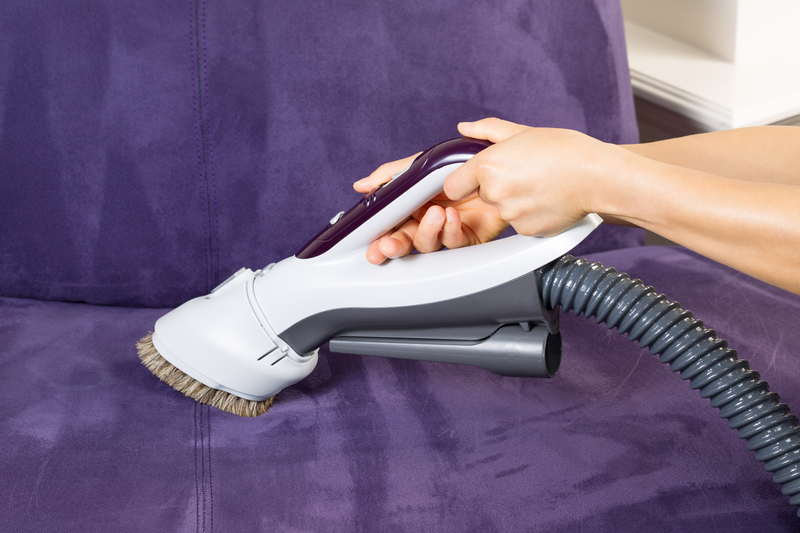Perfectly polished windows with efficient cleaning techniques
Posted on 25/09/2025
Perfectly Polished Windows with Efficient Cleaning Techniques: A Comprehensive Guide
Crystal-clear, streak-free windows not only enhance the aesthetic appeal of any building but also promote a healthy, vibrant atmosphere indoors. Perfectly polished windows stand as a testament to meticulous care and foster a positive impression for both residents and visitors. Whether for homes or organizations, the pursuit of pristine window panes is a worthy endeavor. This article delivers a step-by-step approach to achieving spotless, shining windows using efficient cleaning techniques.

Why Clean Windows Matter
Clean windows offer more than just an enhanced appearance. Here's why professional window cleaning techniques are essential:
- Boost Curb Appeal: Clean, polished windows dramatically strengthen exterior aesthetics.
- Natural Light: Removes grime and dust, letting in more sunlight and brightening interiors.
- Extended Lifespan: Regular cleaning prevents glass degradation caused by contaminants.
- Improved Mood & Productivity: Sunlit rooms create inviting spaces conducive to well-being and work efficiency.
- Cost Savings: Prevents etching and permanent marks, saving on potential costly replacements.
Understanding Your Window Types
Before diving into efficient cleaning methods, it's vital to recognize your window type. Each style may require unique care and attention.
- Single and Double-Hung Windows: Most common in residential settings, these slide up and down.
- Sliding Windows: Move horizontally; frames and tracks collect dust easily.
- Casement Windows: Open outward via hinges; tracks and hinges need detailed attention.
- Bay/Bow Windows: Large panoramic windows with multiple panels, best cleaned methodically panel by panel.
- Skylights: Require specialty tools due to height and angle.
- Stained or Decorative Glass: Needs gentle, non-abrasive techniques.
Essential Tools for a Professional Shine
Achieving perfectly polished windows begins with the right tools. Professional window cleaning is efficient when well-equipped:
- Squeegee: Ensures streak-free results and speedy water removal.
- Microfiber Cloths: Highly absorbent and gentle, preventing scratches.
- Extension Pole: Helpful for tall or hard-to-reach windows.
- Soft-Bristle Brush: For stubborn spots and frames.
- Bucket: To mix solutions and rinse tools.
- Scraper: For stuck-on debris (use with caution).
- Spray Bottle: For controlled application of cleaners.
The Best Window Cleaning Solutions
Discovering a reliable cleaning solution plays a crucial role in effective window cleaning techniques:
- Commercial Window Cleaner: Available in various formulas for streak-free clarity.
- DIY Vinegar Solution: Mix one part white vinegar with one part distilled water for a natural, eco-friendly cleaner.
- Dish Soap and Water: A few drops of mild soap in warm water can tackle greasy residue effectively.
- Rubbing Alcohol: Add to water for added shine and quicker drying.
Pro Tip: Avoid using ammonia-based products on tinted or decorative glass as they can cause damage.
Efficient Cleaning Techniques for Perfectly Polished Windows
Follow this comprehensive, step-by-step guide to ensure your windows are polished to perfection with minimal effort and maximum efficiency.
Step 1: Prepare Your Space
- Remove window screens and gently clean them with soapy water and a soft brush.
- Clear the window sill of any objects, dust, or debris.
- Lay down towels or drop cloths to protect floors or furniture from drips.
Step 2: Dust and Remove Loose Dirt
- Use a dry microfiber cloth or vacuum with a brush attachment to eliminate loose dust from frames, sills, and tracks.
- Don't forget the window corners and weather strips where dirt tends to collect.
Step 3: Apply the Cleaning Solution
- Spray your chosen cleaner generously on the pane.
- If using a bucket, dip your squeegee or sponge, wring out excess liquid, and apply evenly.
- Allow solution to sit briefly on hardened stains or streaks.
Step 4: Agitate and Wipe
- Use a soft-bristle brush or microfiber cloth to gently scrub the glass surface, focusing on sticky or greasy spots.
- Work from the top down for a more uniform finish.
Step 5: Squeegee for Streak-Free Shine
- Starting at the top corner, drag your squeegee horizontally or vertically, wiping the blade after each pass with a clean cloth.
- For best results, slightly overlap each stroke to avoid streaks or missed spots.
Step 6: Detailing and Dry
- Use a dry, lint-free microfiber cloth to remove any remaining water from the edges and corners.
- Check for spots or streaks, giving any problematic areas a quick buff.
Step 7: Reinstall Screens and Clean Extras
- Once the glass is completely dry, reinstall the screens.
- Wipe down exterior sills and frames as a finishing touch.
Advanced Tips for Efficient Window Cleaning
- Clean windows on cloudy days or when the windows are cool to the touch - direct sunlight can cause rapid drying and streaking.
- If cleaning high or hard-to-reach windows, use an extension pole or consider hiring professional window cleaners for safety.
- Tackle stubborn mineral deposits or "hard water" stains with a specialized cleaner or a paste of baking soda and water.
- If working in an area with sticky pollen or pollution, increase cleaning frequency for polished window surfaces.
- Always clean from top to bottom to prevent dripping on already-cleaned surfaces.
Window Polishing: The Secret to a Mirror-Like Finish
Achieving not just clean, but polished glass windows comes down to thoughtful finishing steps:
- After cleaning, lightly buff the dry glass with a fresh, dry microfiber cloth in small circles for added sparkle.
- For a gleaming finish, some experts recommend using a crumpled piece of newspaper - its fibers add gloss without lint.
- Periodically apply specialized glass polish for professional-grade clarity, especially on display or showroom windows.
Common Window Cleaning Mistakes (and How to Avoid Them)
Even with the best intentions, certain habits may inhibit your quest for flawless window panes. Avoid these pitfalls:
- Using Paper Towels: They leave lint and fibers behind.
- Neglecting Window Frames: Dirt from frames can transfer back to glass after cleaning.
- Skipping Routine: More time between cleans allows buildup and requires extra effort later.
- Overuse of Cleaner: Excess solution can lead to streaks and residue if not wiped thoroughly.
- Ignoring the Weather: Cleaning during direct sunlight or rain affects results negatively.
Maintaining the Shine: Window Care Between Cleanings
To keep your glass windows polished and streak-free over time, implement these maintenance practices:
- Wipe away fingerprints and smudges promptly with a dry microfiber cloth.
- Regularly dust window sills and tracks to prevent debris buildup.
- Consider applying an anti-static spray or rain-repellent product on exterior windows to repel dirt.
- Schedule deep cleaning for windows every few months for ongoing brilliance.
Eco-Friendly Window Cleaning Solutions
Adopting green cleaning methods helps protect your home, your health, and the environment. Some eco-conscious alternatives include:
- White vinegar diluted with water as a natural degreaser and glass cleaner.
- Lemon juice for a fresh scent and added cleaning power on stubborn spots.
- Baking soda for gentle scrubbing on frames and sills.
- Reusable, washable cleaning cloths instead of disposable wipes.
When to Call the Experts: Professional Window Cleaning Services
Some situations require specialized equipment, skills, or safety measures:
- Tall, multi-story buildings where ladders or lift systems are needed.
- Big glass surfaces such as storefronts, skylights, or sunrooms.
- Historic properties with delicate or leaded glass.
- Windows with persistent hard water stains or etching.
Expert window cleaners use industrial-grade tools and solutions for highly polished, clear glass and can provide protective treatments for long-lasting brilliance.

FAQs About Window Polishing and Cleaning
How often should I clean my windows?
For residential windows, aim for thorough cleaning at least twice per year; however, monthly touch-ups keep high-traffic or exposed areas sparkling. Businesses with display windows may require weekly or biweekly cleaning.
What's the best season for window cleaning?
Early spring and late fall are ideal, as windows are less dusty and the weather is mild, minimizing streaks from rapid evaporation.
Can I use tap water for cleaning?
While tap water works, distilled water is preferred as it dries without mineral spots or streaks, especially in hard water areas.
How can I prevent streaks on my windows?
Use the right cleaning solution, high-quality squeegee, and fresh microfiber cloths. Always dry and buff the edges for a uniform, polished window finish.
Conclusion: Enjoying the Brilliance of Perfectly Polished Windows
A commitment to efficient window cleaning techniques ensures more than just sparkling glass - it creates a welcoming, bright, and uplifting space for everyone. The look and feel of professionally maintained windows can be achieved by anyone with the right approach, from selecting the best cleaning solution to executing proper technique. Attend to your windows regularly, incorporate these best practices, and bask in the radiant clarity of expertly polished window panes all year long.
Invest in your view, your home, and your inner well-being by embracing the transformative power of beautifully clean windows.





